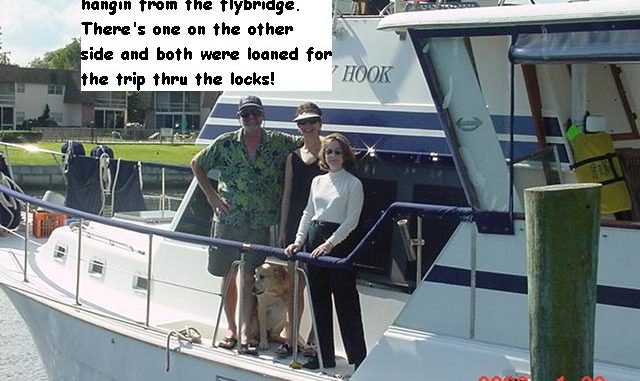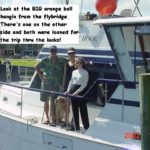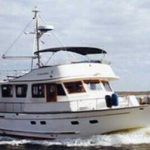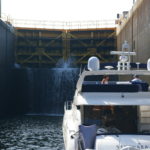
Locking through the Mississippi River system in New Orleans
Here’s an oldie but a goodie, first published back in New Orleans in the local boating rag, PONCHARTRAIN – written under Chris’ pseudonym Gunther P Schwartz…GPS. Even in the late 1990s Chris was teaching through his writing. Although this trip is many years ago and some of the landmarks are washed away from Katrina it still holds the foundations for locking as well as a few pointers about boating in general….enjoy!
On a beautiful Spring Sunday a bunch of trawler types set out on a scenic tour of New Orleans and the Mississippi River. This means we will have to lock in and out of the Mississippi, something most of us have never done although all but Alyse are natives.
Seven a.m. Sunday eight couples, give or take a few straggling singles, board a 50 foot Marine Trader and count up the life jackets. Guess we have to borrow a few more for the all of us now aboard to safely make the journey. Shoving off, we head into Lake Ponchartrain toward the Industrial Canal. The lake is a little bouncy as we wait for the Seabrook Bridge to open, in the down position right now for a passing train.
The CSX bridge is fully operational and opens for us along with all the other bridges leading to the locks. Arriving at the Industrial Locks we are asked to wait with a sailboat for a Red Flag barge which will lock in ahead of us. A Red Flag indicates the barge has flammable and/or toxic cargo and we want to give this a wide berth. Maybe an hour passes then we are invited into the locks. More boats have gathered so we are joined by another trawler, two sailboats, two pushboats, a shrimper and at the last moment one more trawler squeezes in. Who knows when the next lock thru will be.
Fenders are important in the Mississippi River Locks at the Industrial Canal- the bigger the better. Put out as many fenders as you can and be prepared for the rise or fall of a significant water level as your boat slides up or down the concrete walls. We are fortunate to have our own BIG orange fender balls along with the owners regular barrel style fenders. This is a fun trip and we’ll be back at our home dock tonight so we can borrow many more fenders than we usually would carry.
WARNING: if you have a roof line that hangs outboard equal to your hull then be sure to put a fender up on the roof line in addition to those at your rub rail on deck. The roof line will touch the concrete lock wall if the boat leans….and you can count on the boat leaning if you and your passengers are all on the same side to help tie up or set the fenders.
On this day the water rises about 10 feet to match the level of the Mississippi River. The lockmaster equalizes our level then opens the doors to the west. Since we are the first into the lock then we are also first out. As we ease out into the bay we see more pushboats with barges waiting to lock into the Industrial Canal. It really makes a 50 foot yacht feel small when you run past six and eight hundred foot ships sitting at general anchorage.
Idling out into the Mighty Mississippi we turn downriver, easily moving along with the slight 2 knot currents. This time of year the river is usually higher and the current faster but we are lucky. River conditions are kind to us as we head downstream toward the Algiers lock where the Red Flag Barge is currently locking through. So again we wait.
Our turn now to enter the lock and only a few of the pleasure boats have joined us. The others must have headed up river to the French Quarter, a site not to be missed from the riverside but we’ll see that on our return trip.
Dropping about 10 feet to equal the bayou on the west bank, we lock though to the Algiers Canal and continue our journey. The banks are green and rural as we chug past the countryside at 8 knots. It was nice while it lasted but here comes civilization again! Cruising under the high-rise bridge connecting Algiers with Belle Chase and over the Harvey Tunnel, we start to see industry. Barge companies, offshore diving operations and oil field equipment all stacked up in storage lots frame our right side with a mass of swampland and Alvin Calendar Airfield creating the border to our left. Navy jets are landing and taking off all around us.
Ambling on to the intersection of the Harvey Canal, we meet the ICW and turn back toward the Mississippi River. It’s incredible how many shipyards and floating drydocks, big offshore commercial boats and river pushboats are along the ICW.
Passing the “Boomtown Belle” Casino boat we are nearing tourism once again. It’s not often that I travel as a passenger on a boat so I am trying to catch a nap. Suddenly I sense the engines in reverse, hear the noise of feet running in alarm and I am wide awake. Thinking someone has gone overboard I run topside to help. Whew! It’s no big deal- an ice chest lid has fallen over and we’re doing a maneuver to scoop up the lid in a net. Hey! That’s MY lid. Good recovery and nice “man overboard” drill before we get back into the Muddy Mississippi.
One more lock through the Harvey Canal and before we lock thru the lockmaster reminds us to call the Gretna Traffic Light on VHF67. Hmmm. A traffic light for boats? Actually, this system has been in place for a long time and works well to warn other marine traffic, like when the “Brightfield” wrecked into the Riverwalk. So, we call the Gretna Traffic light and ask permission to run down river on the East bank. We’d like to see the city of New Orleans from the riverside of the levee. After granting permission, they monitor our progress on their radar and regulate marine traffic accordingly. Imagine the chaos of barges, tugs, cruise liners, grain ships, oil tankers and pleasure craft in the crescent of such a big river without that special organization and control. Channel 67 can be quite busy when the river is running swift. No chit-chat allowed.
As we exit the lock we are warned about two down-bound vessels and have to wait for them, eventually passing astern of both heading to the east bank. We bounce through the HUGE wakes of those push boats before reaching the calm waters near the Orleans wharfs. Easing back on the throttles we can leisurely enjoy the view including the City of New Orleans’ fire boat. Very kewl.
Abeam of the Morial Convention Center and Riverwalk and fast approaching the Hilton Hotel, we realize that a 50 foot trawler is not a common occurrence in the river. Someone on the upper floors of the hotel is frantically waving from inside the paned glass of his room but no one aboard knows who it is…straining with our binoculars we try to see if we can recognize this would-be friend and he has our full attention…just in time for him to MOON us! Not a shocking sight in The Big Easy but had our sites on other attractions like the French Quarter, Jackson Square, Café Du Monde and the moon walk (…nah!).
The Industrial Locks are soon upon us but we’re experts now. Smooth sailing into the Industrial Canal, we pass Halter’s E-Cat Ferry. This Fast Catamaran is designed to put out a smaller wake than most commercial boats of its size so it won’t harm the environment with huge waves that can erode the shoreline. Another sight (or smell) is the old LOMPOC, a ship converted to a grain barge. We caught a whiff of the grain from a mile away!
The wind begins to howl therefore we launch the Dinghy, removing the extra load from the roof. We expect Lake Ponchartrain to be rough and the weight of a heavy dinghy could compromise the vessel’s stability. Of course, after we go through the motions, towing the dinghy through the Seabrook Bridge and get out into the Lake…not so rough. But the wind remains strong and we are prepared. Safety first is a great motto although not always convenient.
As we near the New Canal Lighthouse and US Coast Guard Station at West End we hear a sailboat calling for help. He has fouled his prop and is taking on water. We communicate by VHF that we are on the way, speed toward him at 8 knots and have our emergency 110VAC bilge pump at the ready. With our generator and long extention cords we could keep him afloat for certain.
Naturally the USCG beat us to the sailboat and by the time we arrive they have everything under control. Thanks are offered to all of us and we continue our trek back to home port at West End.
Our twelve hour journey is fantastic, allowing us to tour our hometown as few people do, from the Mississippi River. This trawler consumed about 60 gallons of fuel – and eight ice boxes of food and beverages the entire day. A happy crew has a hearty appetite and no mutiny is ever started by a happy crew.
Afterthoughts: There is more to boating in New Orleans than just Lake Ponchartrain. Plan your trip by checking the river flood stage and currents. Try to stay down bound and consider taking this journey in Summer or Fall when the River current is the slowest. It turns out it is a wonderful “dry” run for doing the Great Loop. Do it with some seasoned boater friends and as Captain Ron says, “If it’s gonna happen, it’s gonna happen out there!”



